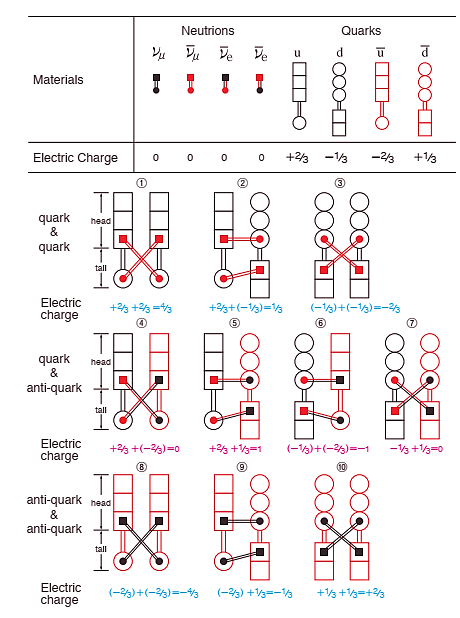M-3: The Emergence of Strong Interaction
Particle Physics
DOI:
https://doi.org/10.55672/hij2022pp91-96Keywords:
Strong interaction, Quarks/anti-quarks(u,u ̅,d,d ̅), Nuclear group ( P,P ̅,n, n ̅ ), π-on group (π^ ,π^-,π^±,π^0), Gluons, NeutrinosAbstract
The conclusion of this paper is that the strong interaction that emerged as the universe developed through the mediation of two pairs of four types of neutrinos (v_µ ,v ̅_µ ,v_e ,v ̅_e) acted on two pairs of four types of quarks/anti-quarks (u,u ̅,d,d ̅) to form two particle groups each having an electrical charge composition of (+1, -1, 0, 0) the π-on group (π^+,π^-,π^±,π^0 ) and the nucleon group ( p, p ̅, n, n ̅), which became the constituent materials for 120 types of atomic nuclei/anti-atomic nuclei. That is, the emergence of strong interaction is the physical force that shouldered the central role within the causal chain that was the development of the universe: From neutrino and quark/anti-quark → nucleon/anti-nucleon → electron/positron, atomic nuclei/anti-atomic nuclei → elements/anti-elements and so on. The quark chromodynamics on strong interaction of the Standard Model however accounts for the emergence of strong interaction as basically the result of the union of three colors/anti-colors of quarks/anti-quarks and is, therefore, no more than the result of a random accident. Hence, the principle of strong interaction according to the Standard Model is not a causal property that emerged in line with the flow of the development of the universe. For that reason, it is not possible for this principle to organize and connect the past, the present, and the future in a sophisticated manner.
Downloads
References
[1] B. Povh, K. Rith, C. Scholz, F. Zetsche, and W. Rodejohann, Teilchen und Kerne: eine Einführung in die physikalischen Konzepte. Springer-Verlag, 2013.
[2] R. M. Barnett, H. Mühry, and H. R. Quinn, The Charm of Strange Quarks: Mysteries and Revolutions of Particle Physics. Springer Science & Business Media, 2013.
[3] N. J. H. I. J. Ozawa, "M-1: The Universe That Emerged and Developed in a Causal Manner," vol. 2, no. 3, pp. 122-127. doi: https://doi.org/10.55672/hij2022pp122-127
[4] N. Ozawa, "M-2: Emergence of Quarks and Anti-Quarks " Hyperscience International Journal, vol. 2, no. 3, pp. 83-88. doi: https://doi.org/10.55672/hij2022pp83-88

Published
How to Cite
Issue
Section
License
Copyright (c) 2022 Hyperscience International Journal

This work is licensed under a Creative Commons Attribution-NonCommercial 4.0 International License.







 Google Scholar
Google Scholar  Crossref
Crossref  Scopus
Scopus  WorldCat
WorldCat  ORCID
ORCID  Scilit
Scilit  Mendeley
Mendeley  Internet Archive
Internet Archive 





